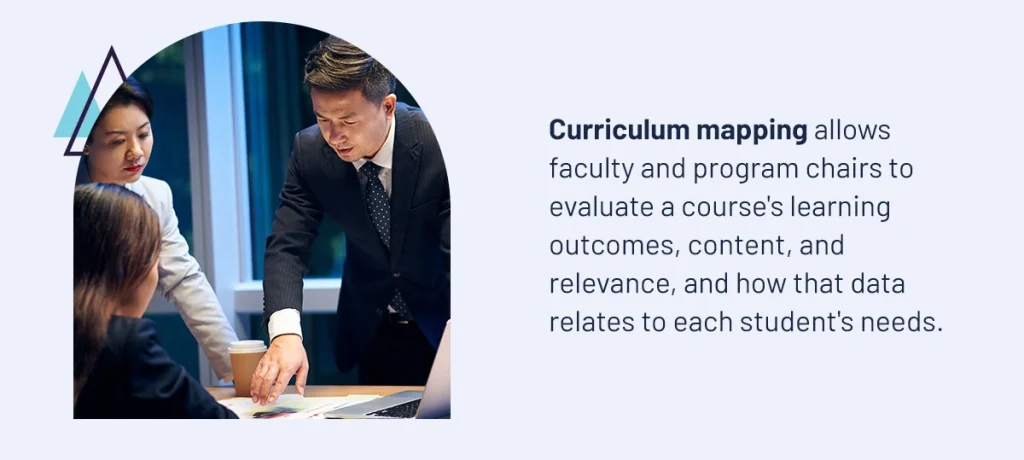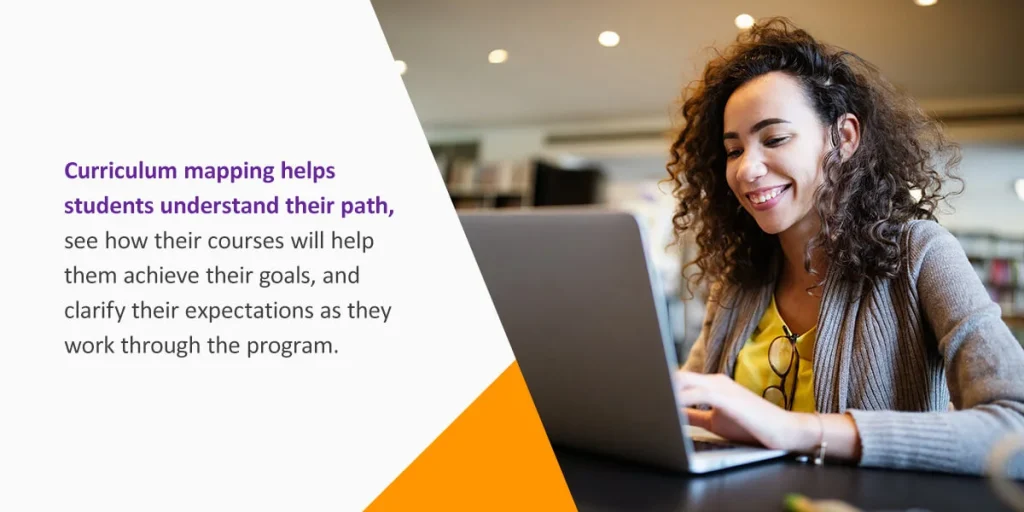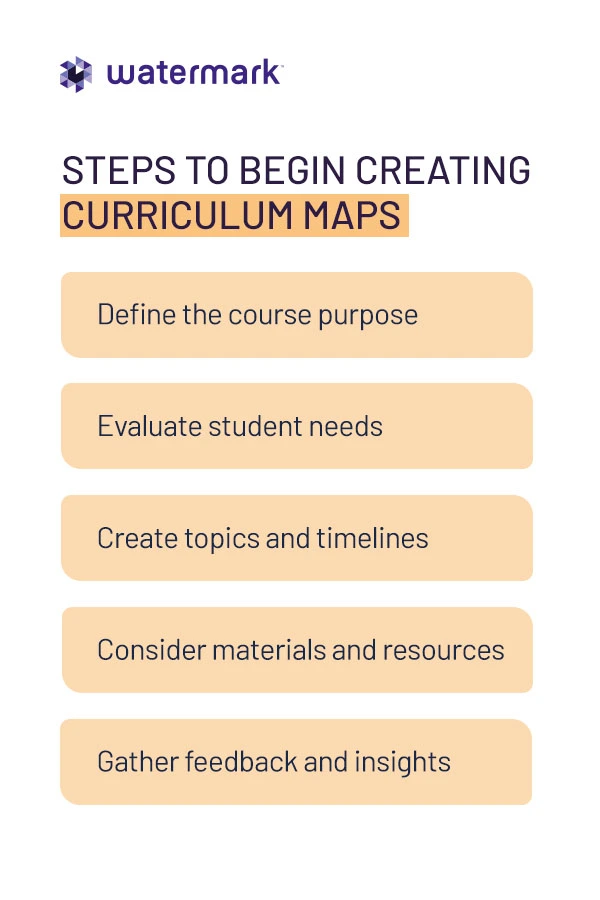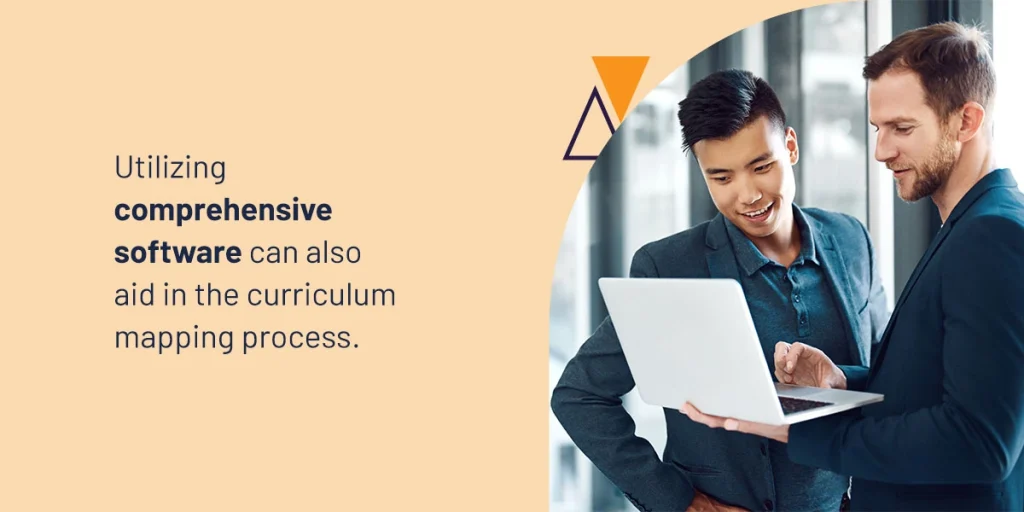
Assessing learning outcomes is critical in higher education, helping educators and administrators answer questions about what skills and content students have learned and what they must master before meeting their educational goals. Yet, having the data and insights to find these answers can be difficult without a plan for measuring learning and outcomes.
Curriculum mapping in education is a key part of the assessment process, offering valuable insights into each program’s ability to deliver specific outcomes. Curriculum mapping is a method of showing the connections between the expected outcomes of an academic program and the specific courses where this learning takes place. Learn more about curriculum mapping and how your higher education institution can utilize the process to help students achieve success.
What is curriculum mapping?
Curriculum mapping is a process where the educators, administrators, and support staff at an institution develop an outline for teaching and assessing learning outcomes throughout the student learning journey. As part of curriculum mapping, educators create learning goals and set the scope and progression of learning across courses and degree programs. They also use curriculum mapping to measure classroom progress and guide future curriculums.
Curriculum mapping is about taking a long view of a student’s educational journey and ensuring that learning outcomes align with what educators teach in the classroom. This tool encourages educators to reflect frequently on learning progress and use data to meet the needs of each student. Ultimately, curriculum mapping lays a strong foundation for your assessment process so that you know where to look when it comes time to report on progress.
What is a curriculum map?
The curriculum mapping process results in a document called a curriculum map that educators can use to assess what and how they will teach content in the classroom. A curriculum map typically looks like a grid or table and provides clear insight into the outcomes students have achieved — and where they should go next. A curriculum map may cover an entire school year. The process guides faculty and students throughout the educational experience.
What is the purpose of curriculum mapping?
Why map learning outcomes to courses? There are quite a few objectives of a well-defined curriculum mapping process:
- Planning a sequence for instruction: You can identify which course should first introduce a student to a concept and how that student should be deemed “proficient.” You can also ensure that outcomes are spread evenly throughout the program.
- Identifying gaps in your program: Are all of your learning outcomes covered in the current courses? Is the student’s path to proficiency clear? Better to find that out in the planning stages!
- Finding opportunities for assessment: When you map outcomes to courses, you can then define how to monitor student progress along the way. Based on the specific course content, you’ll also identify the best ways to assess student learning — projects, exams, and presentations.
- Improving the learning experience: When assessing student learning as they move through a program, you can spot negative trends and adjust the program accordingly by adding new courses or modifying syllabi and assignments.
- Align curriculum with goals and standards: Curriculum mapping allows you to align a program’s content with your mission statement, overarching institutional goals, and educational standards. For example, some accreditation agencies may require you to meet certain curriculum standards, and mapping ensures you’re on the right track.
The benefits of curriculum mapping
If you are wondering why you need to develop a curriculum grid, take a look at these key benefits of curriculum mapping for your higher education institution:
1. Improve student learning
Curriculum mapping supports students as they learn by fostering collaboration between faculty as they create a student-first curriculum. Educators can pool their resources and work together to ensure that students meet expected learning outcomes at the right time before moving on in the program. Curriculum maps close gaps in a program’s curriculum to help students build on their knowledge properly. A curriculum map can also connect degree programs to occupations, helping students turn their skills into careers.
2. Measure learning outcomes
A curriculum map provides signposts for educators and faculty to help them determine how effective their courses were at meeting specific learning objectives. After a course is complete and faculty have assessed learning outcomes, they can compare what they actually taught in the classroom and what learning outcomes students achieved against the curriculum map. When using information this way, a curriculum map is an effective tool for helping faculty understand where learning gaps occur so they can adjust their methods.
3. Create clear objectives for each course
The curriculum mapping process also helps faculty and program chairs better understand how their given course fits into the big picture of each student’s educational experiences and define expectations for student growth as they take additional courses. By outlining outcomes introduced in one class and then reinforced in a later advanced course, you can ensure students develop their knowledge and skills across the curriculum.

Curriculum mapping also helps faculty identify what students should learn in each course. Faculty can create clear objectives for their courses to help with course planning and keep the course on track while in process. Clear objectives also help students understand what they’ll learn or be able to do after completing the course. Setting clear course objectives is also necessary for analyzing whether the course does what you intended it to do and measuring student outcomes.
4. Simplify reporting and tracking
Curriculum mapping allows faculty and program chairs to evaluate a course’s learning outcomes, content, and relevance, and how that data relates to each student’s needs. Since reporting and tracking such data is ongoing, curriculum mapping helps simplify and make these tasks consistent. For example, faculty can use reports on curriculum data to track the impact a course has on student achievement.
In addition, academic chairs can confirm that staff members are teaching outcomes throughout the program, while faculty can take more responsibility for teaching a specific outcome.
5. Use student and faculty time more effectively
Curriculum maps increase collaboration between faculty and staff within a department, which can help educators make the most efficient use of their and each student’s time. With a clear goal for the learning outcomes students should achieve in each class, educators can eliminate redundancies and learning gaps in their courses and across degree programs, ensuring that future course material connects to past learning.
As faculty measure what they taught against the planned curriculum and complete curriculum maps year after year, they see how their courses change over time and become better at planning lessons that meet learning outcomes.
6. Increase student engagement

Keeping students engaged in their learning gives them a sense of purpose, direction, and stake in their education. Curriculum mapping helps students understand their path, see how their courses will help them achieve their goals, and clarify their expectations as they work through the program. For example, visualizing a course’s objectives helps students make connections and know what to expect from the course.
With increased clarity of the curriculum path they’re on, students can take ownership of their education and make deeper connections between courses in the curriculum.
7. Maintain compliance with accreditation standards
If your institution seeks accreditation status or reaffirmation, curriculum mapping helps prove that your faculty and institution are planning, implementing, assessing, and improving curriculum procedures. Curriculum mapping practices contribute to many accreditation processes. Accreditation agencies often require consistent proof that an institution is meeting curriculum benchmarks, as this demonstrates the drive for student success.
You may also need to meet state and national guidelines for educational standards, which curriculum mapping can help you report on and comply with.
8. Encourage faculty collaboration
Curriculum mapping is inherently collaborative. Since various courses, often taught by different faculty members, build on one another and relate to each other, faculty members can work together to create relevant curriculum maps across a program. Collaborating on curriculum maps ensures the courses in a program align with the program’s goals and create a cohesive educational experience for students. Leveraging collaboration during curriculum mapping also strengthens your faculty and creates an overall collaborative culture.
What could Watermark do for your institution?
Creating a curriculum map
The curriculum mapping process should be intentional and focused on keeping track of what students have learned and what comes next. Your unique mapping process may look slightly different as you determine what works best for your institution and students, but you can follow these steps to begin creating curriculum maps:

- Define the course purpose: Defining a course’s purpose is an essential starting point for curriculum mapping. This purpose creates a foundation for the course and learning activities or assignments. When considering a purpose, you evaluate the knowledge students already have, information that will be essential for students to know moving forward, and the skills you can help students obtain through activities or fieldwork. Determining these unique purposes can help tie courses in the same program together while ensuring each one offers unique information students find value in.
- Evaluate student needs: Creating a curriculum map involves understanding student needs and making changes to address these needs. Faculty members can identify difficulty areas or gaps for students by collaborating with other instructors in the same program. Courses should build from each other, empowering instructors to fine-tune student understanding and skills.
- Create topics and timelines: After considering the course purpose and student needs, you can begin crafting a topic framework and timelines to cover this content. Consider the frequency of seeing students during this stage. For example, you may need to tweak timelines if instructors only see students twice a week rather than three times. It can also be beneficial to incorporate opportunities to evaluate student understanding in the timelines and leave some space for adjustments as the course progresses.
- Consider materials and resources: Although course content is a valuable aspect of curriculum mapping, it is crucial to ensure your institution has the materials and resources necessary to deliver essential information in an understandable way. For example, you must consider whether a course will need a textbook, specific equipment, or the necessary funds to obtain these resources.
- Gather feedback and insights: Assessments provide valuable insights about a course’s effectiveness. Although test scores can provide valuable insights about content, other types of assessments can provide additional benefits for instructors. For example, course evaluations and surveys give students the opportunity to ask questions and express their concerns. Midterm and end-of-course assessments can give instructors and institutional decision-makers crucial information to help shape the remainder of the course and build a foundation for the next group of students taking the class. This feedback can help you determine whether gaps remain between courses, if instructors need to address their instructional methods, and more.
The webinar Assessment Foundations: Curriculum Mapping explains how to simplify your curriculum mapping process. These tips for introducing curriculum mapping to your degree program or institution can also help you improve the process:
- Ensure that learning outcomes are specific and measurable: The best learning outcomes are precise and achievable. Consider what skills students who go through a degree program might need in the workforce or as they continue their education.
- Evaluate how your curriculum may need to change: Curriculum maps are excellent sources of guidance for improving your curriculum. Are there some core courses that don’t promote the learning outcomes specified in your curriculum map? Develop the classes so they do.
- Evaluate your curriculum map as you go: Especially in the beginning, you may find that your curriculum map doesn’t align with where you want your curriculum to be. Regularly evaluate the map to determine what’s working, each student’s needs, and how the curriculum map could better serve the students and faculty.
- Use the right tools: Creating a curriculum map can be time-consuming. Consider using software to help you easily collaborate on and share your curriculum map with your institution.
Example of curriculum mapping
While curriculum mapping may produce different results across degree programs, departments, and higher education institutions, the process for each will look similar. When an institution creates a curriculum map for a degree program, the educators, department heads, and other staff involved in the program work together to develop a set of learning outcomes students should achieve. The next step is determining where educators will introduce, reinforce, and assess those outcomes.
To create a curriculum map, the educators and administrators make a table with all the courses in the program. They then determine where to teach and assess each learning outcome. The result is a graph or table educators can use to determine in which courses students should master specific concepts. Educators and administrators may then refer back to the curriculum map when creating lesson plans, evaluating the results of exams and course evaluations, and completing any other curriculum planning.
An example of a curriculum map could look like:
Course Objective 1 Objective 2 Objective 3 Objective 4
101 x x
201 x x x
202 x x x
203 x x x
- Objective one explanation
- Objective two explanation
- Objective three explanation
- Objective four explanation
The above table and the following objectives create a concise overview of which courses in a program will address which objectives and where there will be overlap for students to draw on previous experiences. Instructors and administrators can refer to this table for content creation and use the information to collaborate with others in the department to create a comprehensive and valuable educational program.

Utilizing comprehensive software can also aid in the curriculum mapping process. For example, the University of Northern Colorado simplified the curriculum process by digitizing management and workflows. This solution allowed for streamlined data entry and made insights transparent to stakeholders, allowing them to track progress on curriculum changes and more.
How Watermark helps with curriculum mapping
Your institution’s curriculum and catalogs say a lot about its goals and objectives. Watermark can empower the faculty and staff at your higher education institution to take control of the curriculum mapping process. With Watermark Curriculum Strategy, faculty can upload lesson plans, activities, resources, and other materials to the platform so others can compare curriculum maps. As a result, educators can collaborate to create course catalogs and handbooks for the courses at your institution.
Here are a few ways Watermark Curriculum Strategy helps higher education institutions with curriculum mapping:
- Improved collaboration: With tools for building curriculum proposal and approval workflows, Curriculum Strategy ensures that no one on your faculty is in the dark about curriculum updates. The platform shows the status of every item, which items are missing, and outlines the edits collaborators have made. Curriculum Strategy makes it easy to guide collaborators through reviews and revisions.
- Ensured data accuracy: Data accuracy is vital for curriculum and catalog consistency. Curriculum Strategy provides seamless SIS integration to reduce duplicate data. The platform ensures accurate and consistent data across course descriptions, credit information, requisites, policies, and outcomes. This feature keeps everyone working with the most current information as they collaborate.
- Consistency across print and online versions: Curriculum Strategy allows your institution to publish student handbooks and catalogs to clarify policies. An enhanced print capability enables collaborators to simultaneously update the print and online catalogs. The system also keeps branding consistent across your institution’s content.
Improve your curriculum management with Watermark
Implementing curriculum mapping at your higher education institution is well worth the effort. A curriculum map can keep your institution and students on track with learning achievements, making it easier for faculty and educators to coordinate a curriculum that advances student outcomes.
When your institution is ready to take charge of the curriculum mapping process, Watermark Curriculum Strategy can help. The comprehensive platform allows educators to streamline collaboration and create accessible curriculum maps to connect institutional offerings to the futures of their students. To see our solutions in action, request a demo today.












































































































































































































































































































































































































